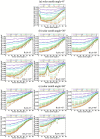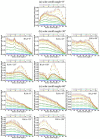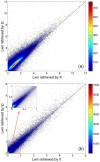A new simple concept for ocean colour remote sensing using parallel polarisation radiance
- PMID: 24434904
- PMCID: PMC3894553
- DOI: 10.1038/srep03748
A new simple concept for ocean colour remote sensing using parallel polarisation radiance
Abstract
Ocean colour remote sensing has supported research on subjects ranging from marine ecosystems to climate change for almost 35 years. However, as the framework for ocean colour remote sensing is based on the radiation intensity at the top-of-atmosphere (TOA), the polarisation of the radiation, which contains additional information on atmospheric and water optical properties, has largely been neglected. In this study, we propose a new simple concept to ocean colour remote sensing that uses parallel polarisation radiance (PPR) instead of the traditional radiation intensity. We use vector radiative transfer simulation and polarimetric satellite sensing data to demonstrate that using PPR has two significant advantages in that it effectively diminishes the sun glint contamination and enhances the ocean colour signal at the TOA. This concept may open new doors for ocean colour remote sensing. We suggest that the next generation of ocean colour sensors should measure PPR to enhance observational capability.
Figures







Similar articles
-
An Ocean-Colour Time Series for Use in Climate Studies: The Experience of the Ocean-Colour Climate Change Initiative (OC-CCI).Sensors (Basel). 2019 Oct 3;19(19):4285. doi: 10.3390/s19194285. Sensors (Basel). 2019. PMID: 31623312 Free PMC article.
-
Rayleigh radiance computations for satellite remote sensing: accounting for the effect of sensor spectral response function.Opt Express. 2016 May 30;24(11):12414-29. doi: 10.1364/OE.24.012414. Opt Express. 2016. PMID: 27410156
-
Polarization-based enhancement of ocean color signal for estimating suspended particulate matter: radiative transfer simulations and laboratory measurements.Opt Express. 2017 Apr 17;25(8):A323-A337. doi: 10.1364/OE.25.00A323. Opt Express. 2017. PMID: 28437919
-
Spaceborne Lidar in the Study of Marine Systems.Ann Rev Mar Sci. 2018 Jan 3;10:121-147. doi: 10.1146/annurev-marine-121916-063335. Epub 2017 Sep 27. Ann Rev Mar Sci. 2018. PMID: 28961071 Free PMC article. Review.
-
[Review of estimation on oceanic primary productivity by using remote sensing methods.].Ying Yong Sheng Tai Xue Bao. 2016 Sep;27(9):3042-3050. doi: 10.13287/j.1001-9332.201609.034. Ying Yong Sheng Tai Xue Bao. 2016. PMID: 29732871 Review. Chinese.
Cited by
-
Atmospheric Correction of Satellite Ocean-Color Imagery During the PACE Era.Front Earth Sci (Lausanne). 2019;7:10.3389/feart.2019.00145. doi: 10.3389/feart.2019.00145. Epub 2019 Jul 26. Front Earth Sci (Lausanne). 2019. PMID: 32440515 Free PMC article.
-
Water-leaving contribution to polarized radiation field over ocean.Opt Express. 2017 Aug 7;25(16):A689-A708. doi: 10.1364/OE.25.00A689. Opt Express. 2017. PMID: 29041040 Free PMC article.
References
-
- Hovis W. A. et al. NIMBUS-7 coastal zone color scanner-system description and initial imagery. Science 210, 60–63 (1980). - PubMed
-
- Platt T. & Sathyendranath S. Oceanic primary production: estimation by remote sensing at local and regional scales. Science 241, 1613–1620 (1988). - PubMed
-
- Morel A. & Antoine D. Small critters - big effects. Science 296, 1980–1982 (2002). - PubMed
-
- Gregg W. W., Conkright M. E., Ginoux P., O'Reilly J. E. & Casey N. W. Ocean primary production and climate: global decadal changes. Geophys. Res. Lett. 30, 1809, 10.1029/2003GL016889 (2003).
-
- Behrenfeld M. J. et al. Controls on tropical Pacific Ocean productivity revealed through nutrient stress diagnostics. Nature 442, 1025–1028 (2006). - PubMed
Publication types
LinkOut - more resources
Full Text Sources
Other Literature Sources

